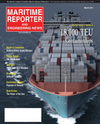
Page 30: of Maritime Reporter Magazine (March 2011)
Ship Repair & Conversion
Read this page in Pdf, Flash or Html5 edition of March 2011 Maritime Reporter Magazine
30 Maritime Reporter & Engineering News
Sloshing is the violent motion of a liquid in a partially filled tank. Liquid natural gas (LNG) transported at -162ºC is under consideration here.
The LNG industry is concerned about the effect of sloshing loads on containment systems and their supporting structures. The fact that the mo- tion in a tank is a function of many parameters and that the resulting impact – spatially localized and including several physical phenomena - interacts with a complex containment system has made sloshing assessment extremely challenging.
LNG carriers have an excellent track record therefore sloshing seemed to have been mastered.
However, advancement is required because the conventional assessment of new membrane LNG carriers traditionally follows the comparative ap- proach along with a filling level limitation on the current fleet. Experience is therefore lacking to assess new designs for FLNG units operating with partially filled cargo tanks.
During the last decade a profound knowledge basis has been created. Together with the indus- try, MARIN has carried out several investigations.
The focus was twofold. On the one hand, com- mercial and Joint Industry Projects such as SALT,
COMFLOW, HAWAI and Off-Loading operabil- ity addressed the reduction of sloshing occurrence by focusing on the factors that define sloshing.
These included environmental conditions, shape and dimensions of the vessels, number, size and geometry of LNG tanks, the filling level of the
LNG tanks and the coupling between the motions of the floating structure and the LNG.
EXTENSIVE RESEARCH
On the other hand, the investigation focused on the sloshing loads and the containment system in- tegrity. This is the subject of extensive interna- tional research. MARIN’s Hydro-Structural
Services (HSS) led part of this research by setting up a confidential and exclusive JIP, “Sloshel”, to- gether with Gaztransport & Technigaz (GTT), Bu- reau Veritas and Shell. Ecole Centrale Marseille, the American Bureau of Shipping, Chevron,
Lloyd’s Register, Det Norske Veritas and ClassNK joined the project later on. The Sloshel project in- cludes full- and large-scale testing of membrane containment systems, numerical developments carried out by Bureau Veritas and validation stud- ies undertaken by the consortium members.
Results of the first full-scale tests carried out by
MARIN at the turn of 2007 were already unveiled in 2009. Unidirectional breaking waves were gen- erated in a flume in order to impact an instru- mented transverse wall with embedded test struc- tures, i.e. a rigid structure and the N096 mem- brane containment system. In 2009, these tests were reproduced at the scale 1 to 6.
MARIN and GTT worked together on the data- base and developed a physical understanding on the scaling of pressure measurements, the struc- tural behaviour of the containment system during impact and the interaction between the wave and raised elements. Sloshing assessment remains a challenging task but the project has helped to sort out the relevant phenomena to formulate common starting points of the assessment methodologies and it has supported design choices.
USER GROUP
The latest test campaign in the Sloshel project ran in April 2010. New full-scale impact tests on the MarkIII membrane containment system and its rigid equivalent were carried out. A series of 142 tests were successively performed. Pressure, strain, acceleration, global forces and corrugation forces were measured and unique, high-speed video recordings were made. The maximum measured pressure was 56 bar and the measured data, visual inspection and destructive testing showed no damage to the MarkIII containment system.
A Sloshel User Group has been set-up to ana- lyze the database of the latest full-scale tests. All of the existing partners joined the group and ex- pressed their willingness to open up the group to new participants. If you would like to take part in the continuing Sloshel project, you are welcome to contact MARIN.
COLUMN EYE ON DESIGN
New Tests Advance Sloshing Knowledge
About the Author
Hannes Bogaert is re- searcher at MARIN, the Mar- itime Research Institute
Netherlands. MARIN offers simulation, model testing, full-scale measurements and training programmes, to the shipbuilding and offshore in- dustry and governments.
For more information: [email protected]
In April 2010 full-scale wave impact tests on the MarkIII membrane containment system were per- formed by MARIN, which mark the latest in a series of dedicated impact tests. An outline of MARIN’s efforts to advise the industry about reducing the risks of sloshing.

 29
29

 31
31
